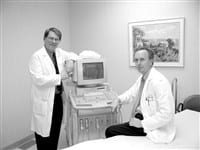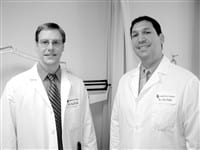In A Different Vein Sufferers of Varicose Veins Now Have Another Option When Seeking Treatment
Until recently, the treatment of varicose veins was an involved, invasive process that left patients unable to work, or even walk, properly for weeks.
With the introduction of new technology using a patented guided catheter and heat source, however, patients being treated for varicose veins may be able to put the spring back in their step much sooner.
The Closure procedure, pioneered by VNUS Medical Technologies, uses a special catheter, guided by ultrasound, to enter a diseased vein through a small opening in the skin. The catheter uses radio frequency (RF) to generate a heat source, which causes the walls of the vein to shrink and close. Blood is then rerouted to healthy veins.
Closure offers an alternative to the most widely-used surgical procedure to treat varicose veins – vein stripping. The procedure literally strips – removes – veins from the legs, and usually requires several weeks of recovery time and involves substantial post-operative pain and bruising. The Closure surgery is also markedly quicker and gentler than vein stripping, according to area surgeons who have only recently begun to offer the procedure, and is a result of the increasing research into less-invasive, more focused surgical procedures across the board.
“The overall trend in medicine is to head toward procedures that require smaller incisions and more comfortable recovery experiences for patients,” said Dr. Jeffrey Kaufman, a vascular surgeon at Vascular Services of Western New England in Springfield. “For some time, people have been trying to come up with less-painful, less-invasive ways to treat varicose veins, and the idea that a catheter and a heat source could be used is what led to this procedure.”
After being trained, vascular surgeons such as those at Vascular Services, and radiologists, who have experience with the use of catheters, are performing the Closure procedure locally.
Dr. James Fanale, chief medical officer and chief quality officer at Mercy Medical Center, said Closure became part of the hospital’s surgical repertoire about three months ago.
“Now, we are completing about one per week,” he said. “It’s an attractive alternative to older methods, which could be torture in terms of recovery.”
The Vein Game
Kaufman conceded that surgeons specializing in vein care haven’t seem many new advances in their field in recent years, but the Closure procedure is an important development in the treatment of a pervasive problem. About 10{06cf2b9696b159f874511d23dbc893eb1ac83014175ed30550cfff22781411e5} to 20{06cf2b9696b159f874511d23dbc893eb1ac83014175ed30550cfff22781411e5} of adults are affected by varicose veins – a specific type of diseased vein caused when the valves of a vein do not function properly and fail to prevent blood from flowing backwards and building up. The backwards flow of blood, called superficial venous reflux, causes the visible swelling and bulging of affected veins. Heredity is a common culprit of the disorder, but prolonged standing, inadequate exercise, and pregnancy often exacerbate the problem as well.
Further, Kaufman said some studies suggest that certain hormonal changes play a part in the development of varicose veins, as most sufferers are women.
But while varicose veins are rarely life threatening, they are not merely a cosmetic issue, he said.
“It’s rare, but very bad varicose veins can erode the skin and bleed,” Kaufman explained. “There is also pain, pressure, and achiness associated with varicose veins in addition to the cosmetic concerns. They are not a life-threatening thing – but they can be quite disabling.”
Kaufman said he and his associates, Drs. Marc Norris and Sang Rhee, have completed about 20 Closure procedures in recent months, with positive results.
“Our early experience has been remarkably good,” he said. “Patients have little or no pain afterward, which is a huge difference from vein stripping. And they are getting back to normal activity in just a few days.”
Kaufman did caution that the surgery is only appropriate for certain cases of varicose veins, and never for spider veins or normal veins a patient might find unsightly. There is some risk of burning the skin, due to the catheter’s heat source, or of clotting or infection, he said, and should only be applied to advanced cases of damaged veins in the legs.
“We are still proceeding conservatively with this procedure,” Kaufman said, noting that any surgery on varicose veins should be performed only after other interventions, such as changes in diet and daily work habits or the use of compression stockings to alleviate the pain and appearance of varicose veins, have been exhausted.
“We don’t look at this procedure as a quick cosmetic fix, and patients should not. Any surgery has risks involved. Still, the surgery seems to be working well in the cases when a surgical intervention is necessary. Basically, this offers another option to many patients.”
In Venous Veritas
Kaufman added that having the Closure avenue to explore not only gives patients another choice to consider, but gives surgeons the ability to combine different methods. These include stripping, saline injections, stab phlebectomy, which creates less scarring than stripping, or laser treatments, in order to best treat the patient for varicose veins and spider veins, which are smaller, more superficial, and usually do not have the same type of pain and discomfort associated with them, but often coexist with varicose veins.
“What we’re looking at here is a procedure that is easier to complete than vein stripping, and which offers an improved outcome for the patient,” added Fanale. “As we learn more, I can’t envision anyone wanting older procedures. And I don’t think this will be the last advance, either.”



Comments are closed.